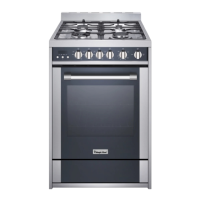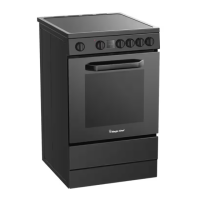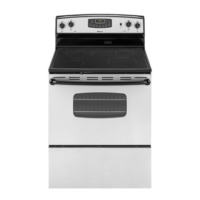SAFETY INSTRUCTIONS
STORAGE ABOVE Besure utensilis large enough toprop- IMPORTANT SAFETY
erly contain food and avoid boilovers. NOTICE AND WARNING
RANGE Pan size is particularly important in
To eliminatethe hazardof reachingover deep fat frying. Be surepan will accom- The California Safe Drinking Water and
hot surface burners, cabinet storage modatethe volume of food that is to be Toxic Enforcement Act of 1986 (Propo-
should not be provided directlyabove a added aswell asthe bubbleactionoffat. sition 65) requires the Governor ofCall-
unit. If such storage is provided, it Never leave adeep fat frying operation fornia to publish a list of substances
should be limited to items which are unattended, knownto the State ofCalifornia tocause
used infrequently and which are safely cancer or reproductive harm, and re-
quires businesses to warn customersof
storedinanareasubjectedtoheatfrom Never let a pan boil dry as this could potential exposures to such sub-
an appliance.Temperatures in storage damage the utensil and the appliance.
areas above the unit may be unsafe for stances.
some items, such as volatile liquids,
cleaners or aerosol sprays. ALUMINUM FOIL Users of this appliance are hereby
Use aluminum foil ONLY as instructed warned that the burning of gas can re-
UTENSIL SAFETY in this book. Improper use of aluminum suitin low-level exposure to someofthe
foil may cause damage to the oven, af- listed substances, including benzene,
Use only pans that have flat bottoms feet cookingresults,and canalsoresult formaldehydeand soot,due primarilyto
andhandles that areeasilygraspedand in shock and/or fire hazards, the incomplete combustion of natural
stay cool• Avoid using unstable, gas or liquid petroleum (LP)fuels. Prop-
warped, easily tipped or loose handled erly adjusted burners will minimize in-
pans. Do not use pans if their handles PLASTICS complete combustion. Exposure to
twistandcannotbetightened. Pansthat Many plastics are vulnerable to heat. these substances can also be mini-
are heavyto move whenfilled withfood Keep plasticsawayfrom partsoftheap- mized byproperlyventingthe burnersto
may also be hazardous, pliance that may become warm or hot. the outdoors.
Always placea panof foodon asurface AEROSOL SPRAYS VENTILATING HOOD
burner before turning iton, and turn it off Many aerosol-type spray cans are EX- To reducethe hazard of storage above
before removing the pan. PLOSIVE when exposed to heat and a range, install a ventilating hood that
may be highly flammable. Avoid their projects at least 5 inches beyond the
Always turn pan handles to the side or use or storage near an appliance, bottom edge of the cabinets. Clean
back of appliance, not out into the room hood frequently to prevent grease from
where they are easily hit or reached by SELF-CLEAN OVEN accumulating on hood or its filter.
Shoulda boiloveror spilloverresult inan
smallchildren. To minimize burns, igni- Donotcleandoorgasket.Thedoorgas- open flame, immediately turn off the
tion of flammable materialsand spillage ket is essential for a good seal. Care hood's fanto avoid spreadingthe flame.
due to unintentional contact with the should be taken not to rub, damage, or After thoroughly extinguishing flame,
utensil, do not extend handles over ad- move the gasket. Do not use oven the fan may be turned onto remove un-
jacent surface burners, cleaners of any kind in or around any pleasant odor or smoke.
part of the self-clean oven. Clean only
paRRslisted in this booklet. Before self-
_._, _1 ._ ,) cleaning the oven, remove broiler pan,
-,f'_'i _ _' oven racks,andother utensils,andwipe
×a#'-/_'_', off excessivespillovers.
It is normal for the cooktop of the range
tobecomehot duringa self-clean cycle.
Therefore, touching or lifting the cook-
top during a clean cycle should be
avoided.
3_

